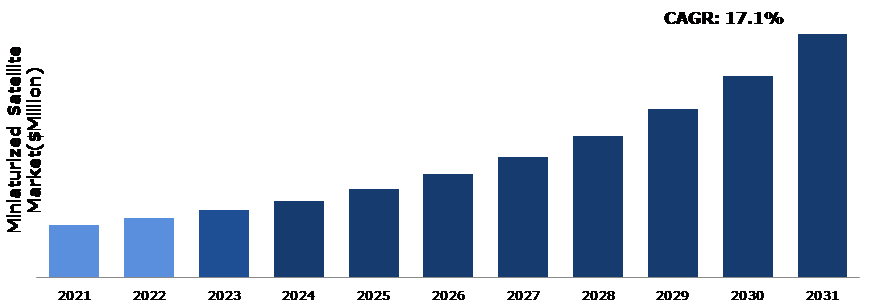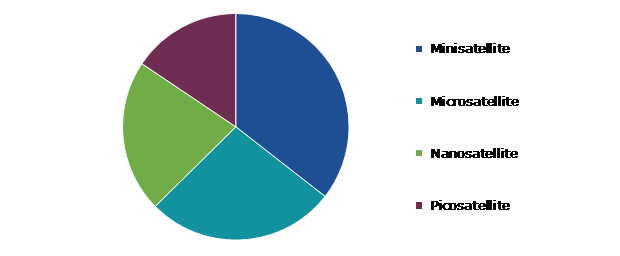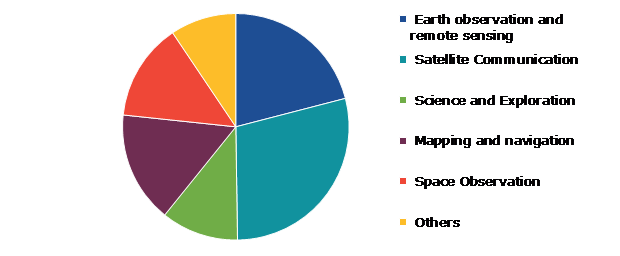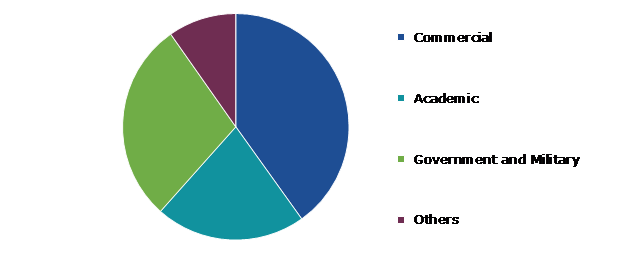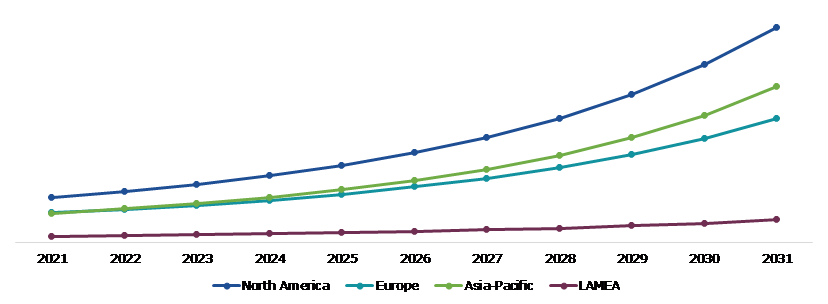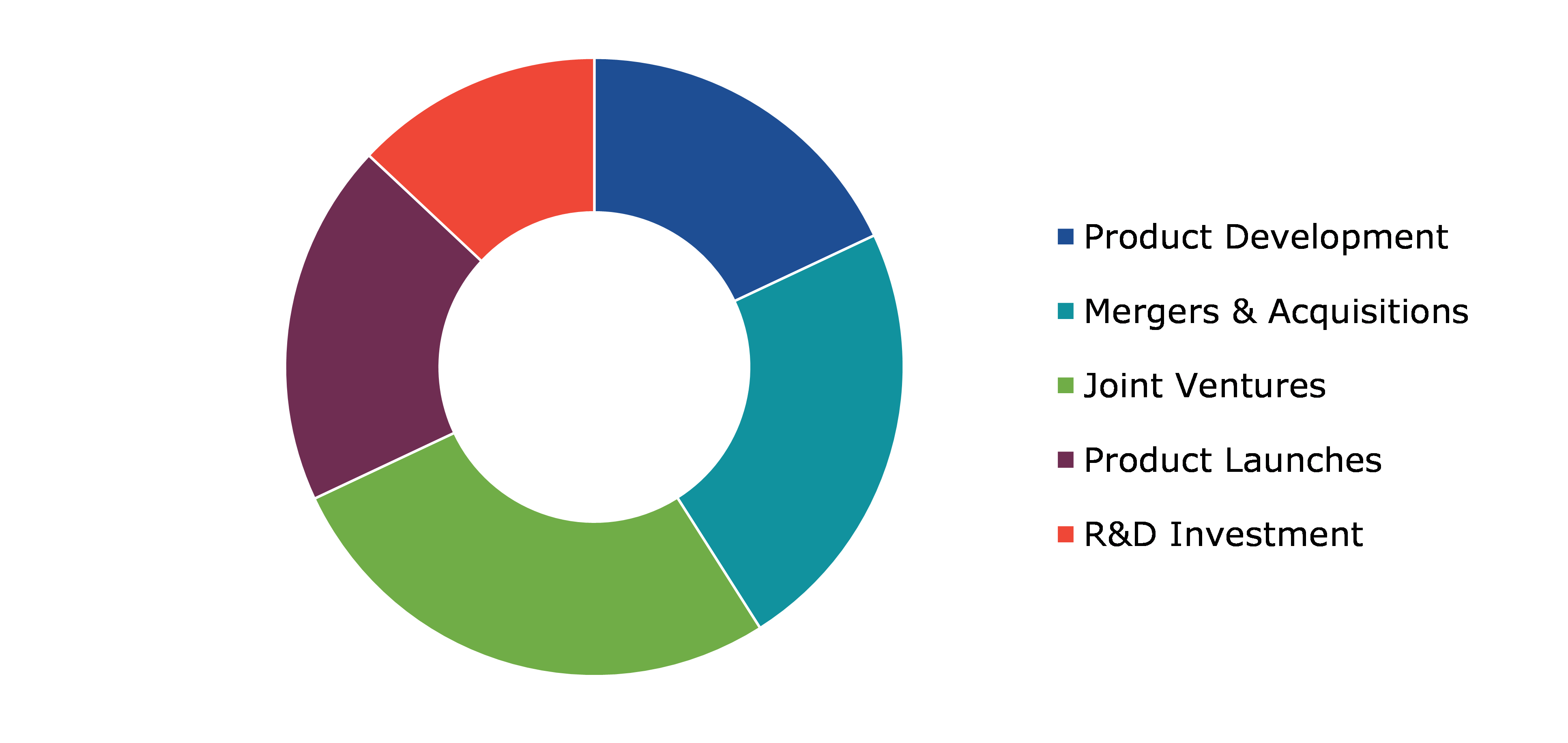Miniaturized Satellite Market Report
RA08661
Miniaturized Satellite Market by Type (Minisatellite, Microsatellite, Nanosatellite, and Picosatellite), Application (Earth Observation & Remote Sensing, Satellite Communication, Science & Exploration, Mapping & navigation, Space Observation, and Others), End-user (Commercial, Academic, Government & Military, and Others), and Regional Analysis (North America, Europe, Asia-Pacific, and LAMEA): Global Opportunity Analysis and Industry Forecast, 2022–2031
Global Miniaturized Satellite Market Analysis
The Global Miniaturized Satellite Market Size was $3,396.2 million in 2021 and is predicted to grow with a CAGR of 17.1%, by generating a revenue of $15,958.6 million by 2031.
Global Miniaturized Satellite Market Synopsis
The primary factor driving the growth of the miniaturized satellite market size during the projected period is an increase in satellite makers' focus on the development of compact satellites due to the lower cost and development time of miniaturized satellites. Furthermore, ride-sharing launch programs have increased demand for small spacecraft. These initiatives increase access to space research, allow numerous satellites to be launched into higher orbits, and lower launch costs. Miniaturized satellites can readily fit into ride sharing payloads alongside other items, reducing deployment time. On the other hand, production costs are low because the need for bulky and costly propulsion systems is eliminated. Furthermore, these miniaturized satellites are constructed with reusable, low-cost components, and technology. Miniaturized satellites allow for a wide range of scientific investigations and technology demonstrations to be carried out in orbit with relative ease. These factors are expected to drive the growth of the miniaturized satellite market growth.
However, the shorter life span of miniaturized satellites could hinder the global miniaturized satellite market's development. The mini satellite has a typical lifespan of 12 to 15 years. When the propellant operates eliminated, the spacecraft must be discarded in a space 'graveyard' orbital spot. The cost incurred to move the satellite to the graveyard has a high capital investment. As a result, the expense element could restrict the global miniaturized satellite market growth.
The development of automation technologies, decreased satellite launch costs, and increased technological ingenuity are all contributing to the growth of the global miniaturized satellite market demand. Due to technological advancement, miniaturized satellites provide entirely new designs for a variety of space activities and have the potential to expedite transformational research by orders of scale. For instance, in January 2021, SpaceX launched a Falcon 9 rocket from Cape Canaveral carrying 143 small satellites. More people are now able to use small satellites around the globe because of the development of reusable rocket technology that has decreased the cost of launch services.
According to regional analysis, the North America miniaturized satellites market accounted for a dominating market share. This is because satellite communication technology provides data, audio, and video services in remote regions. It helps in tracking and monitoring trucks and containers to provide effective logistical assistance. As a result, the need for miniature satellites in the communication and telecom industry in North America is driving the expansion of the miniaturized satellite market forecast period.
Miniaturized Satellite Overview
Miniaturized satellites are designed to reduce the cost of launch vehicles as well as construction costs. Miniaturized satellites are less expensive and easier to mass build. Their major objective is to gather scientific data and relay radio signals. These satellites are available to enterprises of various sizes and are priced accordingly. Little spacecrafts can be mass-produced and marketed at lower prices than bigger satellites due to their shorter development cycle. These satellites are easy to send into orbit and can circle the Earth in higher numbers due to their mini size.
COVID-19 Impact on Global Miniaturized Satellite Market
The COVID-19 pandemic has brought about a number of concerns that have resulted in significant economic losses as many enterprises around the world stopped operating. As a result of supply chain disruptions, the closing of manufacturing facilities, and a global economic slowdown, there has been decreased demand for miniaturized satellites. Businesses and people throughout the globe are still feeling the effects of the COVID-19 outbreak on the miniaturized satellite industry. Customers are investing in new technologies such as new satellite communication trends and technologies such as advanced ground systems, advanced payload systems and very high throughput satellites (VHTS), which is causing companies to scramble to acquire launch contracts and licenses. Due to rising demand for remote sensing and mapping services that do not need huge satellites, small satellite industries had to reduce growth and Research and development activities to offset decreasing sales and operating performance of the space industry. As a consequence of COVID-19, several industry experts expect that the miniaturized satellite business will depreciate.
However, in November 2021, the SpaceX company took new initiative to produce satellites technology. SpaceX has reported the successful deployment of 53 Starlink satellites in the launch of the broadband constellation. Falcon 9 was used to launch the satellites. Around 1,800 Starlink satellites have been deployed by the corporation for global coverage of satellite internet services.
Increasing Popularity of Satellite Connected Internet is Expected to Drive Market Growth
Corporate data (retail and banking), the energy industry (oil and gas), and governments in developed countries are all searching for low-cost miniaturized satellites with increased enterprise data capacity. As a result, demand for low-cost broadband is growing among individual users in developing countries and rural areas where internet access may be limited. These commercial expectations are driving investments in miniaturized satellite-based LEO constellations. Another factor driving down the price per megabit is the rising demand in industrialized countries for low-cost, high-speed internet, which might be satisfied if all of the planned GEO HTS satellites and LEO constellations are built and launched successfully.
To know more about global miniaturized satellite market drivers, get in touch with our analysts here.
Lack of Satellite Launch Vehicles to Restrain the Market Growth
There is a shortage of dedicated miniaturized satellite launch vehicles for small payloads, which would in theory allow relatively reliable, rapid, and dedicated access to a range of orbits and aircraft. These vehicles typically cost more to deploy than their medium- and intermediate-lift equivalents, and the payload may not fully utilize the vehicle's capabilities. Hence, the payload operator might find it difficult to defend the need for the launch vehicle. Competitive pricing, similar complexity to large LVs, scaling down with LV makers' profits declining, and export problems are only a few of the restrictions that pose a challenge to the market.
Adoption of Machine Learning and Artificial Intelligence Anticipated to Create Growth Opportunities
Machine Learning (ML) intelligence on various space development platforms is helping to provide effective communications, improve spacecraft durability, ensure efficient computing capabilities, and improve mission coordination. These satellites are also anticipated to offer governments and humanitarian partners with meaningful data insights. Additionally, the rapid growth in the adoption of ML and AI to provide enhanced services for miniaturized satellites is anticipated to create better growth opportunities in the upcoming year. Moreover, increasing number of small and average players opting for miniaturized satellites is another factor that is projected to create hue growth opportunities for the miniaturized satellite market.
To know more about global miniaturized satellite market opportunities, get in touch with our analysts here.
Global Miniaturized Satellite Market, by Type
Based on type, the market has been divided into minisatellite, microsatellite, nanosatellite, and picosatellite. Among these, the minisatellite sub-segment accounted for the highest market share in 2021, whereas the nanosatellite sub-segment is estimated to show the fastest growth during the forecast period.
Global Miniaturized Satellite Market Share, by Type, 2021
Source: Research Dive Analysis
The minisatellite sub-type accounted for a dominating market share in 2021. The minisatellite was developed in response to rising satellite deployment by telecommunications companies and rising global demand for high-speed internet connectivity. The growth is partly attributable to the massive number of large organizations using miniature satellite technologies to protect data stored on internal servers as well as on cloud gateways. Recent years have seen a growth in data and security concerns, which has driven the product market.
The nanosatellite sub-type is predicted to be the fastest growing during the forecast period. Nanosatellites are a subtype of small spacecrafts that are more affordable than standard satellites and are frequently used for commercial, scientific, and communication purposes. The market for nanosatellites has grown significantly in recent years due to their lightweight properties, faster development cycles, high capability of executing complicated computer operations, and less expensive development and launch expenses.
Global Miniaturized Satellite Market, by Application
Based on application, the market has been divided into earth observation & remote sensing, satellite communication, science & exploration, mapping & navigation, space observation, and others. Among these, the satellite communication sub-segment accounted for highest revenue share in 2021.
Global Miniaturized Satellite Market Size, by Application, 2021
Source: Research Dive Analysis
The satellite communication sub-segment accounted for a dominating market share in 2021. The expansion is attributed to the increased use of communication antennas in the public and private sectors. Broadcasting, telecommunications, and data communications are just a few of the services that satellites offer. Programs for laptops, mobile phones, and personal digital assistants are largely provided by satellites. Since earth observation is used to monitor climate and water, there will probably be significant growth in this market. Due to increased usage of GPS for mapping, aircraft navigation, and agricultural help, navigation will experience significant development. These factors are anticipated to boost the growth of satellite communication sub-segment during the analysis timeframe.
Global Miniaturized Satellite Market, by End User
Based on end user, the market has been divided into commercial, academic, government & military, others. Among these, the commercial sub-segment accounted for highest revenue share in 2021.
Global Miniaturized Satellite Market Growth, by End User, 2021
Source: Research Dive Analysis
The commercial sub-segment accounted for a dominating market share in 2021. Miniaturized satellites are increasingly being used by commercial organizations to deliver cutting-edge services like broadband satellite TV, internet, and other services because of satellite manufacturers' intensive focus on reducing the cost of miniaturized satellites. Miniature satellites can be constructed using reusable and affordable hardware and technology. These factors are anticipated to boost the growth of commercial sub-segment during the analysis timeframe.
Global Miniaturized Satellite Market, Regional Insights
The miniaturized satellite market was investigated across North America, Europe, Asia-Pacific, and LAMEA.
Global Miniaturized Satellite Market Size & Forecast, by Region, 2021-2031 (USD Million)
Source: Research Dive Analysis
The Market for Miniaturized Satellite in North America was the Most Dominant
The North America miniaturized satellite market accounted for a dominating market share in 2021. Satellite communication technology provides data, audio, and video services in faraway regions. It aids in tracking and monitoring trucks and vehicles to provide effective logistical assistance. As a result, the need for mini satellites in the communication and telecom industry in North America is propelling the growth of the miniaturized satellite market trend. For instance, NASA sets aside a budget each year for space-related activities such as science, aeronautics, space technology, exploration, and other space operations. Furthermore, the increased demand for tiny satellites from various end-use industries such as research organizations, military & defense, and telecommunications has fueled regional market expansion.
Competitive Scenario in the Global Miniaturized Satellite Market
Investment and agreement are common strategies followed by major market players. For instance, in January 2022, Virgin Orbit successfully launched seven CubeSats for three clients into orbit on the third straight successful operational flight of their LauncherOne air-launch system. SatRevolution, a Polish smallsat developer, supplied two of the satellites. Spire Global produced one satellite to assess the orbital debris environment in collaboration with the Austrian Space Forum and Findus Venture GmbH. The remaining four satellites were obtained under the Defense Department's Space Test Program.
Source: Research Dive Analysis
Some of the leading miniaturized satellite market analysis players are Airbus, gomspace, L3Harris, Technologies, Inc., Lockheed Martin Corporation, Northrop Grumman Corporation, planet labs inc., Sierra Nevada Corporation, Thales Group, The Aerospace Corporation, and The Boeing Company.
| Aspect | Particulars |
| Historical Market Estimations | 2020 |
| Base Year for Market Estimation | 2021 |
| Forecast Timeline for Market Projection | 2022-2031 |
| Geographical Scope | North America, Europe, Asia-Pacific, LAMEA |
| Segmentation by Type |
|
| Segmentation by Application |
|
| Segmentation by End User |
|
| Key Companies Profiled |
|
Q1. What is the size of the global miniaturized satellite market?
A. The size of the global miniaturized satellite market share was over $3,396.2 million in 2021 and is projected to reach $15,958.6 million by 2031.
Q2. Which are the major companies in the miniaturized satellite market?
A. Airbus, gomspace, L3Harris, Technologies, Inc., Lockheed Martin Corporation are some of the key players in the global miniaturized satellite market.
Q3. Which region, among others, possesses greater investment opportunities in the near future?
A. The Asia-Pacific region possesses great investment opportunities for investors to witness the most promising growth in the future.
Q4. What will be the growth rate of the Asia-Pacific miniaturized satellite market?
A. Asia-Pacific miniaturized satellite market share is anticipated to grow at 18.6% CAGR during the forecast period.
Q5. What are the strategies opted by the leading players in this market?
A. Agreement and investment are the two key strategies opted by the operating companies in this market.
Q6. Which companies are investing more on R&D practices?
A. Airbus, gomspace, L3Harris, Technologies, Inc., Lockheed Martin Corporation are the companies investing more on R&D activities for developing new products and technologies.
1.Research Methodology
1.1.Desk Research
1.2.Real time insights and validation
1.3.Forecast model
1.4.Assumptions and forecast parameters
1.5.Market size estimation
1.5.1.Top-down approach
1.5.2.Bottom-up approach
2.Report Scope
2.1.Market definition
2.2.Key objectives of the study
2.3.Report overview
2.4.Market segmentation
2.5.Overview of the impact of COVID-19 on Global miniaturized satellite market
3.Executive Summary
4.Market Overview
4.1.Introduction
4.2.Growth impact forces
4.2.1.Drivers
4.2.2.Restraints
4.2.3.Opportunities
4.3.Market value chain analysis
4.3.1.List of raw material suppliers
4.3.2.List of manufacturers
4.3.3.List of distributors
4.4.Innovation & sustainability matrices
4.4.1.Technology matrix
4.4.2.Regulatory matrix
4.5.Porter’s five forces analysis
4.5.1.Bargaining power of suppliers
4.5.2.Bargaining power of consumers
4.5.3.Threat of substitutes
4.5.4.Threat of new entrants
4.5.5.Competitive rivalry intensity
4.6.PESTLE analysis
4.6.1.Political
4.6.2.Economical
4.6.3.Social
4.6.4.Technological
4.6.5.Environmental
4.7.Impact of COVID-19 on miniaturized satellite market
4.7.1.Pre-covid market scenario
4.7.2.Post-covid market scenario
5.Miniaturized Satellite Market, by Type
5.1.Overview
5.1.1.Market size and forecast, by Type
5.2.Minisatellite
5.2.1.Key market trends, growth factors, and opportunities
5.2.2.Market size and forecast, by region, 2021-2031
5.2.3.Market share analysis, by country 2021 & 2031
5.3.Microsatellite
5.3.1.Key market trends, growth factors, and opportunities
5.3.2.Market size and forecast, by region, 2021-2031
5.3.3.Market share analysis, by country 2021 & 2031
5.4.Nanosatellite
5.4.1.Key market trends, growth factors, and opportunities
5.4.2.Market size and forecast, by region, 2021-2031
5.4.3.Market share analysis, by country 2021 & 2031
5.5.Picosatellite
5.5.1.Key market trends, growth factors, and opportunities
5.5.2.Market size and forecast, by region, 2021-2031
5.5.3.Market share analysis, by country 2021 & 2031
5.6.Research Dive Exclusive Insights
5.6.1.Market attractiveness
5.6.2.Competition heatmap
6.Miniaturized Satellite Market, by Application
6.1.Overview
6.1.1.Market size and forecast, by Application
6.2.Earth observation and remote sensing
6.2.1.Key market trends, growth factors, and opportunities
6.2.2.Market size and forecast, by region, 2021-2031
6.2.3.Market share analysis, by country 2021 & 2031
6.3.Satellite Communication
6.3.1.Key market trends, growth factors, and opportunities
6.3.2.Market size and forecast, by region, 2021-2031
6.3.3.Market share analysis, by country 2021 & 2031
6.4.Science and Exploration
6.4.1.Key market trends, growth factors, and opportunities
6.4.2.Market size and forecast, by region, 2021-2031
6.4.3.Market share analysis, by country 2021 & 2031
6.5.Mapping and navigation
6.5.1.Key market trends, growth factors, and opportunities
6.5.2.Market size and forecast, by region, 2021-2031
6.5.3.Market share analysis, by country 2021 & 2031
6.6.Space Observation
6.6.1.Key market trends, growth factors, and opportunities
6.6.2.Market size and forecast, by region, 2021-2031
6.6.3.Market share analysis, by country 2021 & 2031
6.7.Others
6.7.1.Key market trends, growth factors, and opportunities
6.7.2.Market size and forecast, by region, 2021-2031
6.7.3.Market share analysis, by country 2021 & 2031
6.8.Research Dive Exclusive Insights
6.8.1.Market attractiveness
6.8.2.Competition heatmap
7.Miniaturized Satellite Market, by End User
7.1.Overview
7.1.1.Market size and forecast, by End User
7.2.Commercial
7.2.1.Key market trends, growth factors, and opportunities
7.2.2.Market size and forecast, by region, 2021-2031
7.2.3.Market share analysis, by country 2021 & 2031
7.3.Academic
7.3.1.Key market trends, growth factors, and opportunities
7.3.2.Market size and forecast, by region, 2021-2031
7.3.3.Market share analysis, by country 2021 & 2031
7.4.Government and Military
7.4.1.Key market trends, growth factors, and opportunities
7.4.2.Market size and forecast, by region, 2021-2031
7.4.3.Market share analysis, by country 2021 & 2031
7.5.Others
7.5.1.Key market trends, growth factors, and opportunities
7.5.2.Market size and forecast, by region, 2021-2031
7.5.3.Market share analysis, by country 2021 & 2031
7.6.Research Dive Exclusive Insights
7.6.1.Market attractiveness
7.6.2.Competition heatmap
8.Miniaturized Satellite Market, by Region
8.1.North America
8.1.1.U.S.
8.1.1.1.Market size analysis, by Type,2022-2031
8.1.1.2.Market size analysis, by Application,2022-2031
8.1.1.3.Market size analysis, by End User,2022-2031
8.1.2.Canada
8.1.2.1.Market size analysis, by Type,2022-2031
8.1.2.2.Market size analysis, by Application,2022-2031
8.1.2.3.Market size analysis, by End User,2022-2031
8.1.3.Mexico
8.1.3.1.Market size analysis, by Type,2022-2031
8.1.3.2.Market size analysis, by Application,2022-2031
8.1.3.3.Market size analysis, by End User,2022-2031
8.1.4.Research Dive Exclusive Insights
8.1.4.1.Market attractiveness
8.1.4.2.Competition heatmap
8.2.Europe
8.2.1.Germany
8.2.1.1.Market size analysis, by Type,2022-2031
8.2.1.2.Market size analysis, by Application,2022-2031
8.2.1.3.Market size analysis, by End User,2022-20318.2.2.UK
8.2.2.1.Market size analysis, by Type,2022-2031
8.2.2.2.Market size analysis, by Application,2022-2031
8.2.2.3.Market size analysis, by End User,2022-2031
8.2.3.France
8.2.3.1.Market size analysis, by Type,2022-2031
8.2.3.2.Market size analysis, by Application,2022-2031
8.2.3.3.Market size analysis, by End User,2022-2031
8.2.4.Spain
8.2.4.1.Market size analysis, by Type,2022-2031
8.2.4.2.Market size analysis, by Application,2022-2031
8.2.4.3.Market size analysis, by End User,2022-2031
8.2.5.Italy
8.2.5.1.Market size analysis, by Type,2022-2031
8.2.5.2.Market size analysis, by Application,2022-2031
8.2.5.3.Market size analysis, by End User,2022-2031
8.2.6.Rest of Europe
8.2.6.1.Market size analysis, by Type,2022-2031
8.2.6.2.Market size analysis, by Application,2022-2031
8.2.6.3.Market size analysis, by End User,2022-2031
8.2.7.Research Dive Exclusive Insights
8.2.7.1.Market attractiveness
8.2.7.2.Competition heatmap
8.3.Asia-Pacific
8.3.1.China
8.3.1.1.Market size analysis, by Type,2022-2031
8.3.1.2.Market size analysis, by Application,2022-2031
8.3.1.3.Market size analysis, by End User,2022-2031
8.3.2.Japan
8.3.2.1.Market size analysis, by Type,2022-2031
8.3.2.2.Market size analysis, by Application,2022-2031
8.3.2.3.Market size analysis, by End User,2022-2031
8.3.3.India
8.3.3.1.Market size analysis, by Type,2022-2031
8.3.3.2.Market size analysis, by Application,2022-2031
8.3.3.3.Market size analysis, by End User,2022-2031
8.3.4.Australia
8.3.4.1.Market size analysis, by Type,2022-2031
8.3.4.2.Market size analysis, by Application,2022-2031
8.3.4.3.Market size analysis, by End User,2022-2031
8.3.5.South Korea
8.3.5.1.Market size analysis, by Type,2022-2031
8.3.5.2.Market size analysis, by Application,2022-2031
8.3.5.3.Market size analysis, by End User,2022-2031
8.3.6.Rest of Asia-Pacific
8.3.6.1.Market size analysis, by Type,2022-2031
8.3.6.2.Market size analysis, by Application,2022-2031
8.3.6.3.Market size analysis, by End User,2022-2031
8.3.7.Research Dive Exclusive Insights
8.3.7.1.Market attractiveness
8.3.7.2.Competition heatmap
8.4.LAMEA
8.4.1.Brazil
8.4.1.1.Market size analysis, by Type,2022-2031
8.4.1.2.Market size analysis, by Application,2022-2031
8.4.1.3.Market size analysis, by End User,2022-2031
8.4.2.Saudi Arabia
8.4.2.1.Market size analysis, by Type,2022-2031
8.4.2.2.Market size analysis, by Application,2022-2031
8.4.2.3.Market size analysis, by End User,2022-2031
8.4.3.UAE
8.4.3.1.Market size analysis, by Type,2022-2031
8.4.3.2.Market size analysis, by Application,2022-2031
8.4.3.3.Market size analysis, by End User,2022-2031
8.4.4.South Africa
8.4.4.1.Market size analysis, by Type,2022-2031
8.4.4.2.Market size analysis, by Application,2022-2031
8.4.4.3.Market size analysis, by End User,2022-2031
8.4.5.Rest of LAMEA
8.4.5.1.Market size analysis, by Type,2022-2031
8.4.5.2.Market size analysis, by Application,2022-2031
8.4.5.3.Market size analysis, by End User,2022-2031
8.4.6.Research Dive Exclusive Insights
8.4.6.1.Market attractiveness
8.4.6.2.Competition heatmap
9.Competitive Landscape
9.1.Top winning strategies, 2021
9.1.1.By strategy
9.1.2.By year
9.2.Strategic overview
9.3.Market share analysis, 2021
10.Company Profiles
10.1.Airbus
10.1.1.Overview
10.1.2.Business segments
10.1.3.Product portfolio
10.1.4.Financial performance
10.1.5.Recent developments
10.1.6.SWOT analysis
10.2.gomspace
10.2.1.Overview
10.2.2.Business segments
10.2.3.Product portfolio
10.2.4.Financial performance
10.2.5.Recent developments
10.2.6.SWOT analysis
10.3.L3Harris Technologies, Inc.
10.3.1.Overview
10.3.2.Business segments
10.3.3.Product portfolio
10.3.4.Financial performance
10.3.5.Recent developments
10.3.6.SWOT analysis
10.4.Lockheed Martin Corporation
10.4.1.Overview
10.4.2.Business segments
10.4.3.Product portfolio
10.4.4.Financial performance
10.4.5.Recent developments
10.4.6.SWOT analysis
10.5.Northrop Grumman Corporation
10.5.1.Overview
10.5.2.Business segments
10.5.3.Product portfolio
10.5.4.Financial performance
10.5.5.Recent developments
10.5.6.SWOT analysis
10.6.planet labs inc.
10.6.1.Overview
10.6.2.Business segments
10.6.3.Product portfolio
10.6.4.Financial performance
10.6.5.Recent developments
10.6.6.SWOT analysis
10.7.Sierra Nevada Corporation
10.7.1.Overview
10.7.2.Business segments
10.7.3.Product portfolio
10.7.4.Financial performance
10.7.5.Recent developments
10.7.6.SWOT analysis
10.8.Thales Group
10.8.1.Overview
10.8.2.Business segments
10.8.3.Product portfolio
10.8.4.Financial performance
10.8.5.Recent developments
10.8.6.SWOT analysis
10.9.The Aerospace Corporation
10.9.1.Overview
10.9.2.Business segments
10.9.3.Product portfolio
10.9.4.Financial performance
10.9.5.Recent developments
10.9.6.SWOT analysis
10.10.The Boeing Company
10.10.1.Overview
10.10.2.Business segments
10.10.3.Product portfolio
10.10.4.Financial performance
10.10.5.Recent developments
10.10.6.SWOT analysis
11.Appendix
11.1.Parent & peer market analysis
11.2.Premium insights from industry experts
11.3.Related reports
Satellites have evolved into an essential tool for modern society, delivering crucial services that have an important influence on our everyday lives. It would be far more difficult and costly to communicate with individuals in different regions of the world without satellites. This is where the miniaturized satellite solution comes in. The miniaturized satellite market has made tremendous advancements in past few years.
Miniaturized satellites are intended to minimize the cost of launch vehicles as well as construction costs. Miniaturized satellites are less expensive and easier to manufacture in large quantities. They are primarily focused on gathering scientific data and transmitting radio signals. These satellites are offered to businesses of all sizes and are priced accordingly. Miniature spacecraft can be mass-produced and sold at lower prices than larger satellites because of their shorter development cycles. These small satellites can circle the planet in larger numbers and are simple to place in orbit.
Recent Trends in the Miniaturized Satellite Market
The miniaturized satellite market is constantly expanding due to advances in technology and rising demand for compact, cost-effective satellites. The commercialization of space has created new potential for miniaturized satellites. Small satellites are being purchased by private corporations for uses like earth observation, communication, and space travel. Moreover, the need for earth observation services has grown recently, especially for uses like disaster management, weather forecasting, and environmental monitoring. Miniaturized satellites are appropriate for these applications because they can offer high-resolution photographs of the Earth's surface at a lesser cost than standard satellites.
Newest Insights in the Miniaturized Satellite Market
As per a report by Research Dive, the global miniaturized satellite market is expected to grow at a CAGR of 17.1% and generate revenue of $15,958.6 million by 2031. The primary factors driving the growth of the market are the growing popularity of miniaturized satellites among small and average players, the fact that satellite manufacturers are placing more emphasis on the development of compact satellites, the swift adoption of ML and AI to provide improved services for miniaturized satellites, and miniaturized satellites' cheaper prices and shorter growth time.
The miniaturized satellite market in the North America region is expected to remain dominant in the coming years. The region’s high revenue in 2021 was driven by the growing demand from a variety of end-use industries, including telecommunications, military & defense, and research groups, for miniature satellites. This has led to an increased need for qualified individuals in the field of miniaturized satellite technology, such as designers, engineers, and technicians.
How are Market Players Responding to the Rising Demand for Miniaturized Satellite?
Market players are responding to the rising demand for miniaturized satellites by investing in research and development to create more advanced and efficient miniaturized satellite technologies. They are also exploring new business models and collaborations to meet the growing demand for miniaturized satellites and their accompanying services.
In addition, market players are increasingly focusing on strategic partnerships and collaborations with other players in the industry to leverage their strengths and expand their reach. Some of the foremost players in the miniaturized satellite market are Airbus, Gomspace, L3 Harris, Technologies, Inc., Lockheed Martin Corporation, Northrop Grumman Corporation, Planet Labs, Inc., Sierra Nevada Corporation, Thales Group, The Aerospace Corporation, The Boeing Company, and others. These players are focused on implementing strategies such as mergers and acquisitions, novel developments, collaborations, and partnerships to reach a leading position in the global miniaturized satellite market.
For instance:
- In January 2020, SpaceX, a company that produces spacecraft, launches rockets, and deploys satellite communications, launched its 3rd batch of 60 mini-satellites into orbit, as part of its plans to establish a massive constellation of thousands of spacecraft that will constitute a global broadband internet infrastructure.
- In March 2022, NASA, a federal agency of the United States that operates independently, launched a brand-new, next-generation satellite for the National Oceanic and Atmospheric Administration (NOAA). The satellite will provide information about weather and dangerous environmental conditions in the western hemisphere.
- In May 2023, Rocket Lab USA, a top manufacturer of rockets and space systems, finally completed the first of two dedicated Electron launches, which will install a constellation of tropical storm monitoring satellites for NASA.
COVID-19 Impact on the Global Miniaturized Satellite Market
The COVID-19 pandemic had an adverse impact on the global miniaturized satellite market. During the pandemic, supply chain delays, manufacturing facility closures, and an economic downturn worldwide reduced the demand for miniaturized satellites. Clients were investing in new technologies like new satellite communication trends and technologies such as advanced payload systems, advanced ground systems, and very high throughput satellites (VHTS), forcing companies to work to acquire launch agreements and licenses. Moreover, owing to increasing demand for remote sensing and mapping services that do not require large satellites, small satellite firms had to restrict expansion and R&D operations to offset declining sales and operating performance in the space industry. These factors significantly hindered the miniaturized satellite market growth amidst the pandemic.
Personalize this research
- Triangulate with your own data
- Request your format and definition
- Get a deeper dive on a specific application, geography, customer or competitor
- + 1-888-961-4454 Toll - Free
- support@researchdive.com

